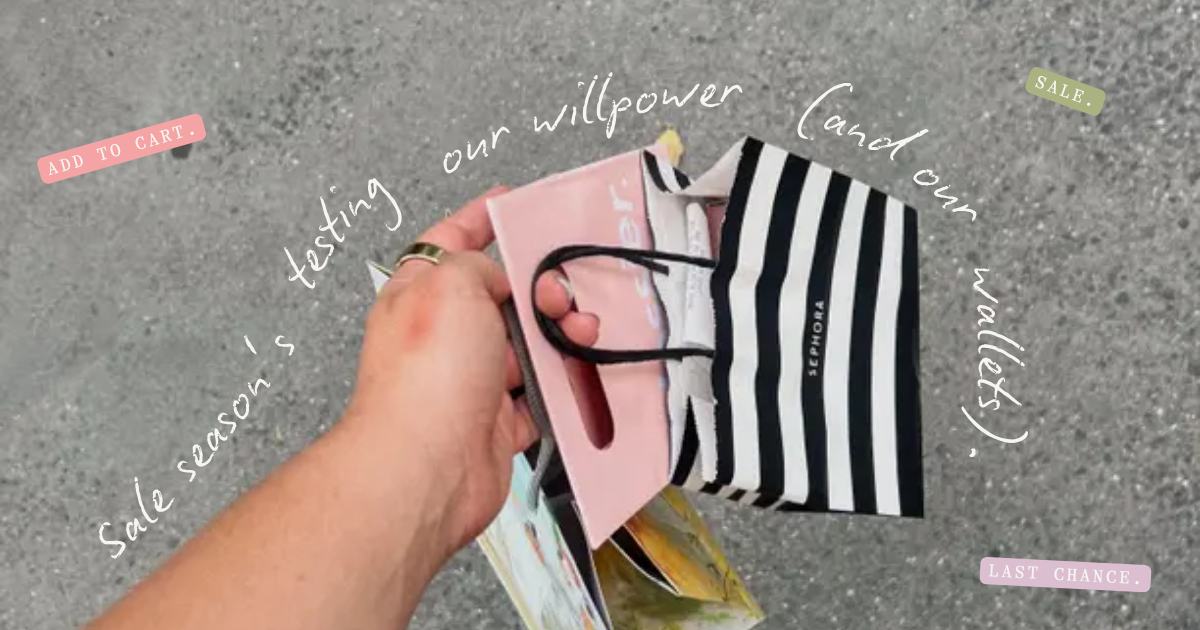How to Curb Dopamine Spending (Tips from the SOTM Community)
The internet’s yelling “add to cart,” but we’re here to help you pause first.
You know the feeling: a bad day, a boring afternoon, or a scroll through Instagram... and suddenly that "add to cart" finger is twitching. And honestly, it’s even harder right now. Between Black Friday and Cyber Monday, every brand is promising their “best offer ever” -your inbox, ads, and favourite influencers included. (We see you, “only 2 hours left” emails. It’s brutal out there.)
We call it dopamine spending chasing that little hit of happiness from a new purchase, even if we do not really need the thing.
It is a super common money habit, and our She's on the Money community recently shared some absolutely brilliant, practical, and unhinged (their words!) tips for keeping it in check.
If you are looking to cut down on impulse buys, here are some of the best ideas:
1. The 48-Hour Rule (and Variations)
This is a classic for a reason: wait before you buy.
Chloe shared:
"Anytime I’m thinking about buying something, I go online and put a bunch of things I’d like into the basket... then leave it a day or two (or nine!)."
Others said they wait 24, 48, or even 72 hours or until payday to decide if they really still want it.
2. Swap Spending for Saving
Carly had a genius hack:
"For any non-essential purchase over $50, I stop, check, and move the money to Sharesies. It’s an even better dopamine hit!"
Love this one turning the impulse into an investment instead.
3. Trick Your Social Feeds
Kelly shared this hilarious tip:
"Change your FB demographic age to older and to male, so you start getting ads for completely non-specific products like walking frames and lazy boy chairs."
Cutting down on tempting ads = fewer impulse buys.
4. Click & Collect to Curb In-Store Temptation
Eve said:
"I’m terrible at the supermarket because I see things and just want them... doing click and collect has been a GAMECHANGER."
Seeing your total as you shop helps you stick to your list.
5. Reframe the Cost
Several people recommended this mindset shift:
Claire:
"I think about how many hours of hard work I would have to do to buy the item and if it’s worth it."
Kat also shared this helpful question:
"If someone offered you the item or the cash value of it, and you’d pick the cash, then you shouldn’t buy it."
6. Replace the Dopamine Hit
Lots of creative ideas here!
→ Move the money to savings
→ Donate to charity instead (as Kacey said, "it will perk you up!")
→ Buy shares (from Allie: "then you're buying, but it's sort of saving")
→ Sell things instead of buying (Rebecca: "I get a similar dopamine rush from selling things!")
→ Borrow books from the library (Lauz: "the thrill of new without actual $")
7. Track Your Triggers
Hope shared:
"I wrote down every single transaction and what the transaction was for... worked really well."
Others mentioned tracking impulse buys to spot patterns (boredom, stress, certain apps).
8. Give Yourself Permission — With Boundaries
The SOTM team also loves this one: budget for treats.
Having a "fun fund" or a small set amount for guilt-free spending can help reduce the feeling of restriction (which often leads to binge spending later).
Final Thoughts.
Impulse spending is so normal especially in this scroll-happy, ad-heavy world. But as this community thread showed, a few clever habits can really help.
Here is your dopamine spending toolkit:
✅ Wait before you buy
✅ Turn spending impulses into saving wins
✅ Tweak your social feeds
✅ Shop more intentionally (click & collect, tracking, lists)
✅ Reframe costs and swap the dopamine hit
✅ Give yourself permission, with boundaries
And if you want an extra boost, check out our free 30 Day Reframe Challenge it is all about hitting pause on the mindless spending cycle and building better habits. You can join here.
***Please remember our blogs aren’t intended as financial advice - they’re intended only as a starting point to give you a little extra info! For more in-depth advice catered to your personal financial position, please see a certified financial advisor.

